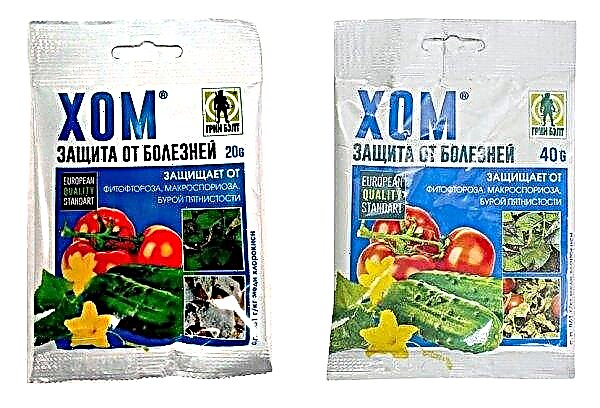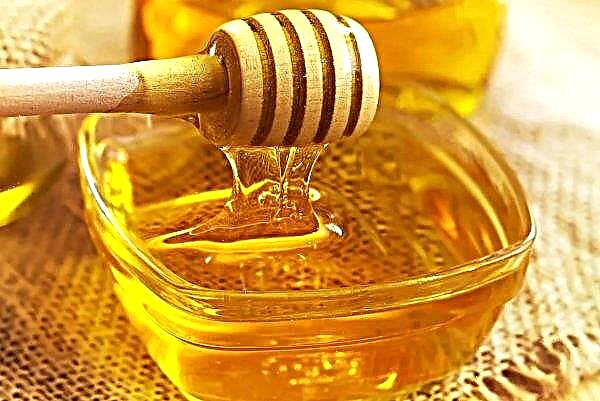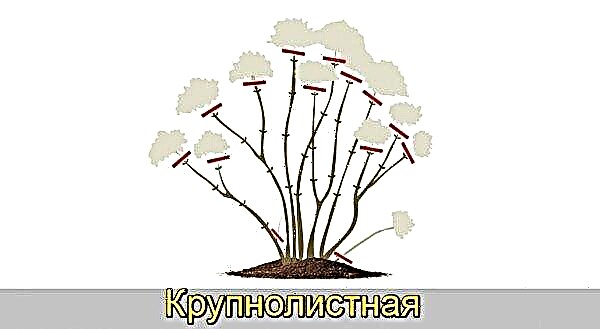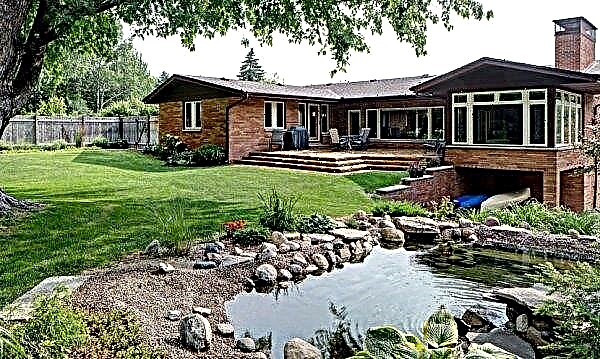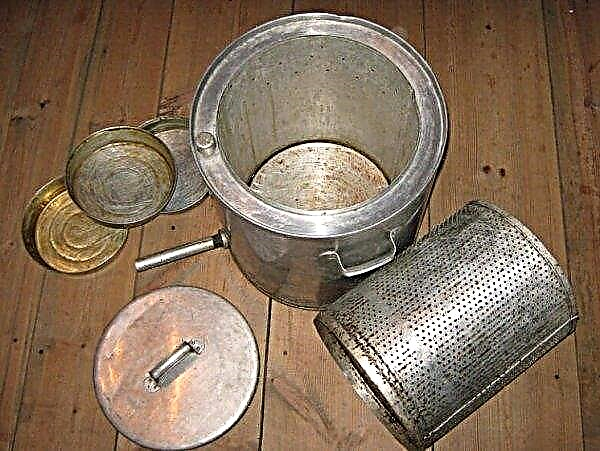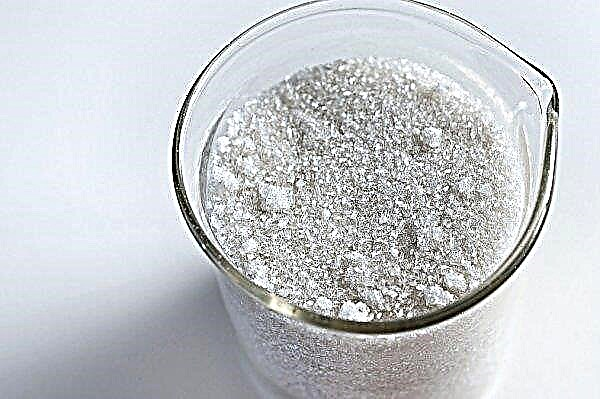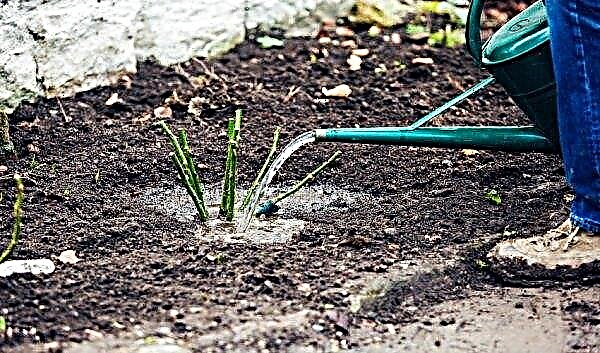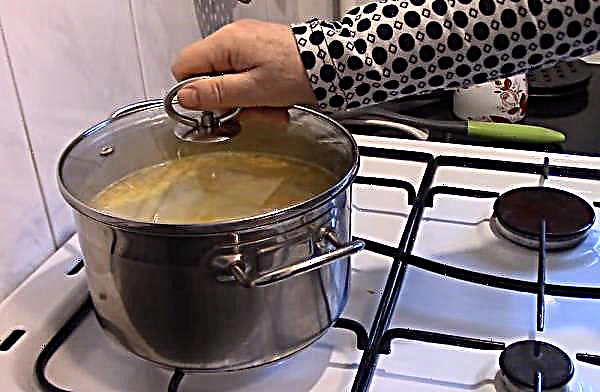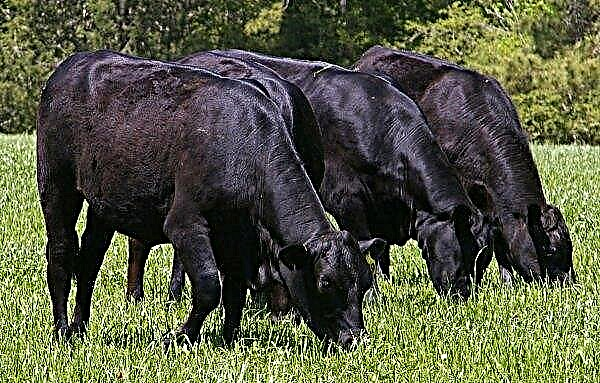Blight affects tomatoes at high humidity, which depends on weather conditions and is often inherent in greenhouses. The spores of this fungal disease are in the soil, and the best remedy for it is preventive measures. For this, they often resort to spraying with copper sulfate preparations. What is copper sulfate, what are the advantages and disadvantages of its use, and how should it be used against late blight?
What is copper sulfate
Copper sulfate is a crystalline hydrate of copper sulfate. It is represented by small crystals of blue. They give the solution of copper sulfate fungicidal, insecticidal and antiseptic properties. Such drugs are very popular among gardeners. They not only resist disease, but also nourish plants with trace elements - copper and sulfur. Copper sulfate is low toxic to humans and other warm-blooded creatures, but toxic to smaller living organisms.
Did you know? Lack of copper causes tomato leaf chlorosis, twisting and whitening, and necrotic spots. Most often found on peatlands and sandy soil.
Is it possible to spray tomatoes from late blight
Copper sulfate solutions have long been used to combat various diseases of cultivated plants and are excellent against late blight. Bordeaux liquid is the most popular, where lime is used along with copper sulfate. It is often added to foliar top dressing and is usually used for prophylaxis, since it perfectly destroys phytophthora spores. Although the compound itself is toxic, the plant does not absorb it (it always remains on the surface, therefore it is considered safe). When the first signs of late blight appear, which appears during temperature changes or rainy weather, the relevance of the use of solutions of copper sulfate increases significantly. The first signs of late blight of tomatoes are as follows: dark spots on the foliage, stalk and fruits, blackening and falling of the ovary.
When the first signs of late blight appear, which appears during temperature changes or rainy weather, the relevance of the use of solutions of copper sulfate increases significantly. The first signs of late blight of tomatoes are as follows: dark spots on the foliage, stalk and fruits, blackening and falling of the ovary.
Benefits
- The use of this substance has several advantages:
- low cost and high availability;
- reliable and proven tool;
- ease of use;
- lack of harmful consequences for humans;
- foliar top dressing of a tomato;
- there is no getting used to it;
- begins to act quickly (within 2-3 hours after application);
- depressing effect on all fungal diseases of plants;
- protects tomatoes from certain types of insect pests.
Disadvantages
- However, this tool, tested over many years, still has some disadvantages:
- some toxicity;
- the protective film from this substance is washed off by precipitation;
- the possibility of errors in the preparation of the solution. If you prepare a weak solution, the drug will not act against fungi as needed, but if too strong - you can burn the plant;
- the finished solution is not stored.
Tomato processing time
Most often, copper sulfate is used for preventive purposes, without waiting for late blight. The first treatment is done already when sowing seeds in the ground. Since late blight lives in the soil, disinfection of the soil mixture and containers with a solution of copper sulphate is carried out when sowing seeds, picking tomatoes into separate containers. In the future, land is being cultivated in the place of planting bushes of seedlings. Then spraying is carried out 20 days after the seedlings are planted on beds of open ground. Under favorable weather conditions for the development of late blight, such spraying can be repeated every 10-15 days, but the last treatment is done no later than a week before harvesting.
Then spraying is carried out 20 days after the seedlings are planted on beds of open ground. Under favorable weather conditions for the development of late blight, such spraying can be repeated every 10-15 days, but the last treatment is done no later than a week before harvesting.
Did you know? There are varieties of tomatoes resistant to late blight. For example, De Barao, Budenovka, Profitable and many others. But they are not 100% safe from late blight, although the likelihood of this fungal disease is much lower.
How to prepare the solution
To protect tomatoes from phytophthora, a simple solution of copper sulfate is used (Bordeaux or Burgundy liquid can be prepared with it). The preparation of the solution contains its own nuances:
- first blue crystals must be diluted with a small amount of water heated to 40–50 ° C. For 100 g of substance, take 1 liter of liquid;
- concentrated solution is diluted in the required amount of water;
- to prepare the concentrate, you can not take iron containers.
Video: how to prepare a solution of copper sulfate
Dosage and proportions
For the treatment of the soil and the plant itself against late blight, different doses of copper sulfate are used:
- seed soaking - 0.01-0.05%. Use 1 g per 10 liters of water;
- spraying of the ground part - 0.1%. To obtain it, take 10 g of copper sulfate in 10 l of water;
- soil disinfection and tomato planting - 1%: 100 g is diluted in 10 l of water;
- for a better effect on the soil (especially if late blight took place) and when sowing seeds - from 3%. To obtain a 3% solution, 300 g is diluted in 3 liters of warm water, then poured into a 10-liter bucket and added another 7 liters.
Step cooking
To prepare a 1% solution of copper sulfate, you need:
- Dilute in a plastic bowl 100 g of blue crystal powder. For breeding use 1 liter of water, heated to 40 ° C.
- Dissolve the resulting solution in a 10-liter bucket, pouring 9 liters of water into it.
- If necessary, strain through gauze.
Important! The solution retains all its properties for 9 hours. The next day, he will already be unsuitable.
Processing of tomatoes with copper sulfate from late blight
In general, the use of solutions of this chemical protective agent can be divided into 3 stages.
First step
It is carried out before sowing seed material of tomatoes. To do this, process the soil mixture and containers for sowing seeds with a solution of copper sulfate in a concentration of 3%. This prevention of the appearance of not only late blight, but also other fungal diseases. The procedure is carried out several days before sowing.
Second phase
In the phase of 2-3 leaves, tomato seedlings are transplanted into separate containers. New soil and dishes are also being processed, but with a 1% solution of copper sulfate. Then the plants dive into a new container. If it is purchased, then you can not disinfect it, but if reused, then this procedure is already needed. Disinfection is done a day before the picking of tomato seedlings.
Third stage
It begins before transplanting seedlings to a permanent place. On the beds reserved for tomatoes, the soil is treated with 1% solution of copper sulfate. The necessary amount of solution should be correctly calculated (based on the fact that 1 liter of the prepared liquid should be poured into each well). For this, a large amount of liquid is usually prepared. It is necessary to worry about the availability of the required volumes of the starting materials in advance. This procedure is performed a day before transplanting. It is recommended to combine it with the introduction of organic fertilizers into the wells. Next, only foliar spraying is carried out with 0.1% solutions of copper sulfate. The first such treatment is recommended after 2 weeks after planting the seedlings (or when the first ovaries appear). Further processing largely depends on the situation on the site, climatic and weather conditions.
It is recommended to combine it with the introduction of organic fertilizers into the wells. Next, only foliar spraying is carried out with 0.1% solutions of copper sulfate. The first such treatment is recommended after 2 weeks after planting the seedlings (or when the first ovaries appear). Further processing largely depends on the situation on the site, climatic and weather conditions.
Did you know? Phytophthora spores begin active life at a temperature of more than 10 ° C and humidity of 75%, which remains high for at least two days. They can be located not only in the soil, but also carried by the wind over long distances from the site of damage.
How to process a greenhouse with copper sulfate
In the conditions of a protected ground against the background of high humidity, fungal diseases of plants are not uncommon. Therefore, the processing of the greenhouse from late blight should be given special attention. Processing of sulphate in a greenhouse is usually carried out in the fall, based on the following conditions:
Processing of sulphate in a greenhouse is usually carried out in the fall, based on the following conditions:
- In the absence of pests and diseases, a 0.75–1% solution is used. To prepare it, take 75-100 g of powder per 10 liters of water. The resulting liquid is wiped over the entire surface of the greenhouse.
- If diseases and pests have occurred, then a two-time treatment is carried out with a 2% solution (200 g per 10 l).
- To treat the surface of wooden structures, a more concentrated solution is made (700 g per 10 l).
- To disinfect the soil, a weak solution is needed (5 g per 10 l). They spray the soil at the rate of 2 liters per 1 square. m
Important! It is especially necessary to process lower part the surface of the greenhouse, which is in contact with the soil cover.
In the prepared greenhouse, first, all surfaces are washed with a solution of copper sulfate twice with an interval for drying of 5 hours. To better clean the surface of the solution, a little grated laundry soap should be added to it. Then spraying the soil.
Features of soil treatment
The most concentrated solution is made before sowing the seeds, when the tanks and soil are treated with a 3-5% solution of copper sulfate. Subsequent soil treatment during diving and landing on the beds is carried out with a 1% solution. If phytophthora at your site is a frequent guest, then the disinfection of the planting site is carried out with a 3% composition a week before the seedlings are planted. To disinfect the soil of greenhouses, 5 g of the substance is dissolved in 10 liters of warm water and the soil is watered at the rate of 2 liters of the finished mixture per square meter of land. A 1% Bordeaux liquid with an addition of calcium hydroxide is also suitable, which will destroy many insect pests, and not just fungal diseases.
To disinfect the soil of greenhouses, 5 g of the substance is dissolved in 10 liters of warm water and the soil is watered at the rate of 2 liters of the finished mixture per square meter of land. A 1% Bordeaux liquid with an addition of calcium hydroxide is also suitable, which will destroy many insect pests, and not just fungal diseases.
Copper sulfate is useful when there is a lack of copper in the soil. So, chernozems have a sufficient content of this microelement for plant crops, but soddy, podzolic, sandy, marshy soils need little top dressing. In this case, once every five years, the soil is fertilized from a proportion of 1 g of copper per 1 square. m of land.
Important! It is worth considering that copper sulfate accumulates in the soil, which can reduce its fertility indicators.
Additional tips
Gardeners give the following recommendations on the use of copper sulfate against late blight tomato:
- it is advisable not to use the chemical after the formation of buds on tomato bushes;
- if phytophthora has already shown itself on tomatoes, then copper-containing preparations are simply necessary;
- if late blight has severely affected the tomato bush, then treatment with chemicals will not save. Such a bush is better to tear out and dispose of completely;
- if burns appear on the leaves after spraying, it is better to cut them off, since such foliage will not recover;
- spraying should not be carried out in rainy weather or before heavy rains. For this, dry, calm weather with an air temperature of up to + 30 ° C is ideal. Disinfection of the soil of the greenhouse is best done in the autumn;
- you can not prepare the solution in reserve or leave it the next day, since it is not stored;
- carry out work on the processing of this chemical in a greenhouse with open doors.

Processing Precautions
Copper sulfate is a harmful chemical, therefore, when processing tomatoes, you should follow these precautions:
- during the spraying procedure, there should be no animals, children or other people on the site - only the person who carries out the treatment;
- if there are bees, then they must not be allowed to the garden for 5–20 hours;
- it is forbidden to eat, drink, smoke during use;
- for the convenience of spraying liquid, you should use certain sprayers;
- when working with the drug, be sure to wear gloves, glasses to protect the eyes. Apply respiratory protection (dressing, respirator);
- after such disinfection, wash your hands, face and other exposed skin with warm water and soap (or even better, take a shower and replace clothes);
- storage of the chemical should be carried out out of the reach of children and pets;
- work away from sources of drinking water;
- Observe the recommended dosage of the chemical and water.
Copper sulfate is a proven and reliable tool for the fight and prevention against late blight. When preparing it, it is very important to make the right dosage, since concentrations that vary greatly are made for processing the soil and the ground. Processing the greenhouse used for growing tomatoes has its own characteristics.

